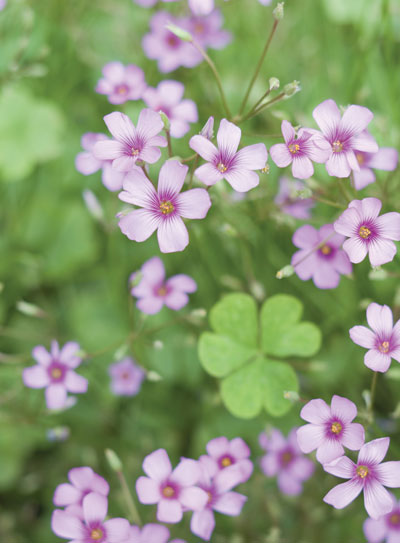
Oxalis, also known as sour grass or wood sorrel, dominates the wooded ecosystems of the coast and Pacific Northwest. While the flowers, bulbs and leaves of some varieties are edible and said to possess medicinal properties, oxalis can also be invasive in a garden.
Spreading by seed, oxalis grows vigorously and is happy in either sunshine or shade. It is also sometimes referred to as a false shamrock because of its leaf resemblance in shape. Many neglected yards and gardens can be completely overtaken by this perennial weed.
Freeing your garden from oxalis can easily take more than one season, possibly as many as seven, and you may never really get rid of this invasive weed completely. However if you follow these suggestions, it will likely take about three years to rid your garden of almost all oxalis.
It’s important to weed before the oxalis goes to seed. Weeding in winter is best, just before the plant starts producing bulb offsets and lateral runners, usually in February or March. The most effective but also most labor-intensive method of control is to pull up as many of the runners as possible, following them back to the roots, and removing the entire root slowly and carefully. Weeding is generally easiest after a rain (if we’re lucky enough to even get any rain in February) when the ground is somewhat moist and soft.
A second method is to pull out the above-ground parts only. Doing this for four or five years may eliminate much of your oxalis permanently. Because the foliage feeds the bulb, depriving the bulb of its stored energy will eventually kill it. Again, it’s important to be consistent and thorough.
Another option is to use a weed mat or cloth for two consecutive years, which is somewhat effective, but not as much as the above methods.
Herbicides like Round Up have proven ineffective in reducing oxalis populations, so your best bet is to use the weeding methods. Also, using harsh chemical herbicides that will eventually seep into the ground and then into our water system, is not recommended.
If you are lucky enough to have a lawn, your best defense against oxalis is to maintain a healthy lawn. If your lawn is thriving, oxalis will have less of a chance to grow or invade. If you notice a patch of oxalis, immediately dig it out or pull up the entire root. Plant grass seed and repair any thin or bare areas of the lawn.
Once you have freed your garden of oxalis, keep it at bay by applying a thick layer of mulch between plants. Mulch will deprive weeds of the sunlight they need to thrive. When using for weed control, coarse-textured mulches like bark and wood chips can be applied up to four inches deep. Keep mulches several inches from tree trunks and plant stems to prevent disease.
See you around the house!








